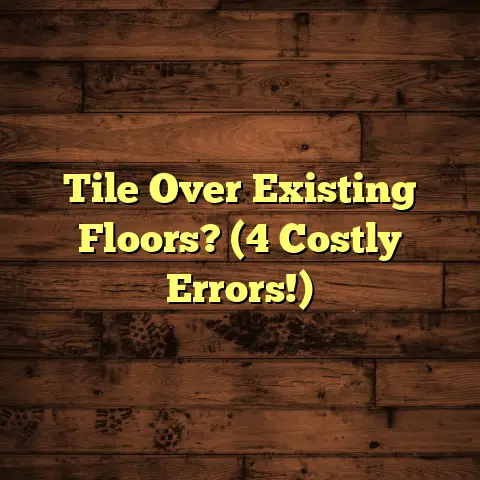Prep Hardwood Floors Before Poly? (7 Steps!)
Did you know that properly prepared hardwood floors can increase the lifespan
of your finish by up to 30%?
I’ve seen it firsthand!
That’s a huge difference between a floor that looks amazing for years and one that starts peeling or bubbling way too soon.
In this article, I’m going to walk you through
the seven crucial steps to prepping your hardwood
floors before you even think about applying
polyurethane.
Trust me, skipping these steps is
like building a house on a shaky foundation.
Let’s dive in and get your floors ready for a finish that’ll last!
Section 1: Understanding Polyurethane Finishes
So, what exactly is polyurethane?
It’s a synthetic
resin that creates a tough, protective coating.
Think of it like a shield for your beautiful
hardwood floors.
It’s commonly used on hardwood because it’s durable,
water-resistant (to a point!), and relatively easy
to maintain.
You’ll find it in both oil-based
and water-based formulas.
Benefits of Polyurethane:
- Durability: Withstands scratches, scuffs, and everyday wear and tear.
- Ease of Maintenance: Simple to clean with regular sweeping and occasional mopping.
- Water Resistance: Protects against spills (but don’t let them sit!).
- Variety of Sheens: Available in matte, satin, semi-gloss, and gloss finishes.
But here’s the thing: even the best polyurethane
won’t perform well if the floor underneath isn’t
properly prepped.
That’s why preparation is
absolutely key.
Section 2: The Importance of Preparing
Hardwood Floors
Imagine spending all that time and effort applying
polyurethane, only to have it start peeling or
bubbling a few months later.
Frustrating, right?
I’ve seen it happen too many times.
Improper
preparation is the culprit behind most hardwood
flooring finish failures.
Potential Issues from Improper Preparation:
- Peeling: The finish doesn’t adhere properly and starts to flake off.
- Bubbling: Air or moisture trapped underneath the finish causes unsightly bubbles.
- Uneven Finish: Variations in the surface result in a blotchy or inconsistent appearance.
- Poor Adhesion: The finish doesn’t bond well with the wood, making it susceptible to damage.
- Contamination: Dust, dirt, or old finish residue interfere with the bonding process.
I remember one time, a homeowner tried to save time
by skipping the sanding step.
Big mistake!
The new
finish looked terrible, and he ended up having to
redo the entire floor.
Talk about a time-consuming
and expensive lesson!
Proper preparation might seem like extra work upfront,
but it’ll save you time, money, and headaches in
the long run.
Trust me on this one.
Section 3: Step 1 – Clear the Area
Okay, let’s get started! The first step is simple but crucial: clear the area.
That means removing everything from the room:
furniture, rugs, lamps, curtains – the works.
You want a completely empty canvas to work with.
Tips for Clearing the Area:
- Wrap Furniture: If you can’t move furniture out of the house, wrap it in plastic sheeting to protect it from dust and debris.
- Store Items Properly: Store rugs and other soft items in a clean, dry place to prevent them from getting dusty or damaged.
- Protect Adjacent Areas: Cover doorways and hallways with plastic sheeting to contain dust.
A clean workspace is essential for a successful
finish.
You don’t want dust or dirt getting trapped
underneath the polyurethane.
Think of it like baking a cake.
You wouldn’t start
mixing ingredients on a dirty counter, would you?
The same principle applies to hardwood flooring.
Section 4: Step 2 – Inspect the Floor
Now that the area is clear, it’s time to become a
floor detective!
You need to carefully inspect the
hardwood for any signs of damage or issues.
What to Look For:
- Scratches and Gouges: Minor scratches can usually be sanded out, but deep gouges may require filling.
- Loose Boards: Loose boards can cause squeaking and should be secured before refinishing.
- Water Damage: Look for discoloration, warping, or cupping, which may indicate water damage.
- Old Finish Residue: Check for areas where the old finish is peeling or flaking.
- Nail Holes: Countersink any protruding nails and fill the holes.
Take your time and really examine the floor.
Use a
flashlight to highlight any imperfections.
Addressing these issues before applying
polyurethane is critical.
Otherwise, you’ll just
be sealing the problems underneath the finish.
I once worked on a floor where the homeowner had
ignored some loose boards.
After the refinishing,
they were even more noticeable because the new
finish highlighted the unevenness.
Section 5: Step 3 – Clean the Surface
Alright, time to get your hands dirty (well, not
too dirty!).
Cleaning the surface is essential
for removing dust, dirt, and old finish residue.
The Cleaning Process:
- Sweep or Vacuum: Start by thoroughly sweeping
or vacuuming the floor to remove loose debris.
Use a vacuum with a soft brush attachment to avoid scratching the wood. - Damp Mop: Use a damp mop with a mild
wood floor cleaner to remove any remaining dirt
or grime.
Be sure to wring out the mop thoroughly to avoid soaking the floor. - Tack Cloth: After damp mopping, use a tack
cloth to pick up any remaining dust particles.
Tack cloths are sticky cloths that are specifically designed for this purpose.
Cleaning Solutions:
- Mild Dish Soap: A few drops of mild dish soap in a bucket of water can be effective for removing dirt and grime.
- Wood Floor Cleaner: Use a commercially available wood floor cleaner that is specifically designed for hardwood floors.
- Vinegar and Water: A solution of equal parts vinegar and water can be used to clean hardwood floors, but be sure to use it sparingly.
Avoid using harsh chemicals or abrasive cleaners, as these can damage the wood.
I always recommend using a tack cloth as the final
step.
It’s amazing how much dust can still be
lingering even after sweeping and mopping.
Section 6: Step 4 – Sand the Floors
Now we’re getting to the heart of the matter:
sanding!
Sanding is crucial for creating a smooth,
even surface for the polyurethane to adhere to.
Step-by-Step Sanding Guide:
- Rent or Buy a Sander: You’ll need a drum sander for large areas and an edge sander for corners and along walls.
- Choose the Right Grit: Start with a coarse
grit sandpaper (e.g., 36-grit) to remove the old
finish and level the floor.
Then, gradually move to finer grits (e.g., 60-grit, 80-grit, 100-grit) to smooth the surface. - Sanding Pattern: Sand with the grain of the
wood, overlapping each pass by about 50%.
Keep the sander moving to avoid creating dips or grooves. - Edge Sanding: Use an edge sander to sand along
walls and in corners.
Be careful not to damage the baseboards. - Hand Sanding: Use a sanding block or orbital sander to sand any areas that are difficult to reach with the drum or edge sander.
Tips for Optimal Results:
- Empty the Dust Bag Frequently: A full dust bag can reduce the sander’s efficiency.
- Wear a Dust Mask: Sanding creates a lot of dust, so it’s important to protect your lungs.
- Inspect Your Work: After each sanding pass, inspect the floor for any imperfections.
- Take Your Time: Sanding is a time-consuming process, so don’t rush it.
Sanding can be intimidating, but it’s essential for achieving a professional-looking finish. If you’re not comfortable doing it yourself, consider hiring a professional.
I always tell my clients that sanding is where the
magic happens.
It’s the key to transforming a dull,
worn-out floor into a beautiful, smooth surface.
Section 7: Step 5 – Repair Damage
Remember that inspection we did earlier?
Now it’s
time to address any damage we found.
Common Types of Damage and How to Fix Them:
- Scratches and Gouges: Fill minor scratches
and gouges with wood filler.
Apply the filler with a putty knife, making sure to overfill the area slightly.
Once the filler is dry, sand it smooth. - Loose Boards: Secure loose boards by driving
nails or screws through them into the subfloor.
Countersink the nails or screws and fill the holes with wood filler. - Gaps Between Boards: Fill gaps between boards
with wood filler or rope caulk.
Apply the filler or caulk with a putty knife, making sure to pack it tightly into the gaps. - Damaged Boards: Replace severely damaged
boards with new ones.
Cut the damaged board to the proper length and remove it from the floor.
Install the new board using nails or screws.
Materials Needed for Repairs:
- Wood Filler: Choose a wood filler that matches the color of your hardwood floor.
- Putty Knife: Use a putty knife to apply wood filler and rope caulk.
- Nails or Screws: Use nails or screws to secure loose boards and install new boards.
- Rope Caulk: Use rope caulk to fill gaps between boards.
- Wood Glue: Use wood glue to help secure new boards.
Allow the repairs to dry and set completely before proceeding to the next step.
I’ve seen some pretty creative repairs over the years.
One time, a homeowner used coffee grounds mixed with
wood glue to fill a scratch.
It actually worked
surprisingly well!
Section 8: Step 6 – Final Cleaning and
Dust Removal
You’ve sanded, you’ve repaired, and now it’s time
for one last cleaning blitz!
Removing every trace
of dust is crucial for a flawless finish.
Methods for Dust Removal:
- Vacuum Thoroughly: Use a vacuum with a soft brush attachment to vacuum the entire floor, paying special attention to corners and along walls.
- Tack Cloth Again: Go over the entire floor
with a tack cloth to pick up any remaining dust
particles.
Use a new tack cloth for this step. - Inspect Carefully: Use a flashlight to inspect
the floor for any remaining dust.
If you see any, repeat the vacuuming and tack cloth steps.
A dust-free environment is critical for achieving a flawless finish. Even a small amount of dust can cause imperfections in the polyurethane.
I like to use a shop vac with a HEPA filter for this
step.
It’s more powerful than a regular vacuum and
can capture even the finest dust particles.
Section 9: Step 7 – Apply a Wood Conditioner
(if needed)
Okay, this step is optional, but it can make a big difference in the final result, especially on certain types of wood.
When and Why to Use a Wood Conditioner:
- Softwoods: Softwoods like pine and fir tend to
absorb stain unevenly, resulting in a blotchy finish.
A wood conditioner helps to even out the absorption. - Porous Woods: Porous woods like ash and oak can also benefit from a wood conditioner.
- To Prevent Blotching: If you’re concerned about blotching, using a wood conditioner is a good idea, even on hardwoods.
How to Apply Wood Conditioner:
- Apply Evenly: Use a brush, roller, or rag to apply the wood conditioner evenly over the entire floor.
- Follow the Manufacturer’s Instructions: Be sure to follow the manufacturer’s instructions for application and drying time.
- Wipe Off Excess: After the recommended drying time, wipe off any excess conditioner with a clean rag.
Allow the conditioner to dry completely before applying the polyurethane.
I’ve found that using a wood conditioner can really enhance the beauty of the wood and create a more uniform finish.
Conclusion
Wow, we’ve covered a lot!
From clearing the area to
applying wood conditioner, each of these seven steps
is crucial for a successful polyurethane application.
Remember, taking your time and paying attention to
detail is key.
Don’t rush through the preparation
process.
It’s an investment in the long-term beauty
and durability of your hardwood floors.
With these steps, I am confident that you can tackle this project and achieve a beautiful, durable finish that enhances the beauty of your hardwood floors.
Call to Action
Now I want to hear from you!
Have you ever refinished
hardwood floors before?
What challenges did you
encounter?
Share your experiences or ask questions
in the comments below.
Let’s learn from each other
and create a community of DIY enthusiasts!





